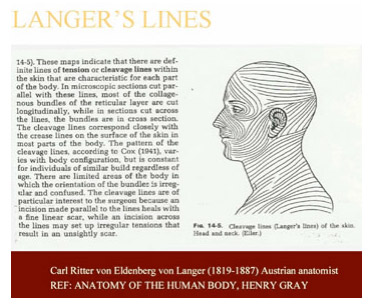
Langer’s lines are lines of tension or cleavage within the skin that are characteristic for each part of the body. In microscopic sections cut parallel with these lines, most of the collagenous bundles of the reticular layer are cut longitudinally, while in sections cut across the lines, the bundles are in cross section. The cleavage lines correspond closely with the crease lines on the surface of the skin in most parts of the body. These cleavage lines are of particular interest to the surgeon because an incision made parallel to the lines heals with a fine linear scar, while an incision across the lines may set up irregular tensions that result in an unsightly scar. In other areas of the body Langer’s lines are visible or can easily be seen by compressing the skin. On the scalp Langer’s lines are not obvious due to the presence of hair and thickness of the skin.
In hair restoration surgery, Langer’s lines are violated routinely. The incision used during the midline sagittal ellipse scalp reduction (when not closed under tension) creates a cosmetically acceptable scar as it is oriented parallel to Langer’s lines (sagitally). Invariably, scars that violate these lines create wider scars when healed. The less parallel the incision to Langer’s lines the wider the scar. The incisions used during scalp lifting on the vertical temporal hairlines and diagonally across the frontal area violate Langer’s lines and always create scars that are wider than sagitally in the midline. The incisions used posteriorly during the Frechet triple flap slot correction are not parallel to Langer’s lines and create wider scars. These are only two examples of the violation of Langer’s lines created with scalp stretching procedures and in my opinion the scars are not acceptable.
A circular punch violates Langer’s line in 358 of its 360 degrees (99.4%). It is parallel at only two degrees. The elliptical punch should create less scarring as it violates these lines less. An incision made with a straight scalpel along the lines in the sagittal plane violates these lines the least, not at all. Incisions, 1.5mm to 2.0mm in length, made with microsurgical sharp point scalpels oriented parallel to Langer’s lines create no scarring when the appropriate sized grafts are inserted.
Hair restoration that can be accomplished with the least amountof scarring will be the most aesthetically acceptable. Elevated grafts, depressed grafts, color changes (hypo and/or hypopigmentation), and noticeable scars negatively alter our canvas and perception of the result regardless of the number of hairs transplanted per square centimeter. The scalp is the canvas upon which we perform our art and the best results are created on the scalp thatis the least altered.
